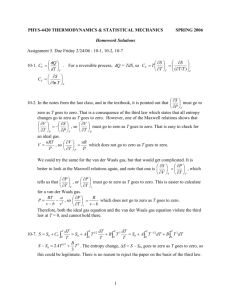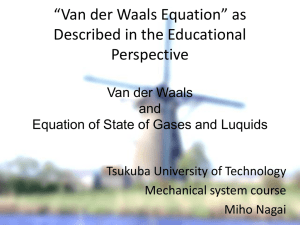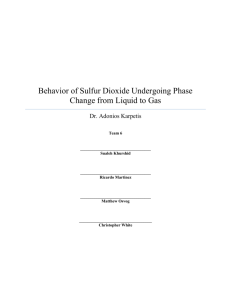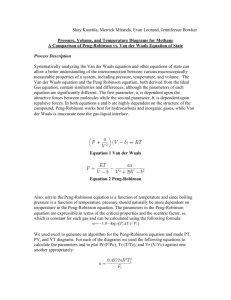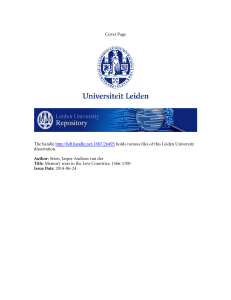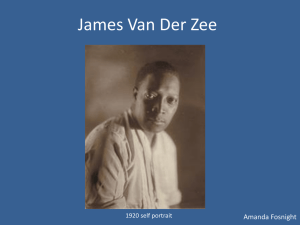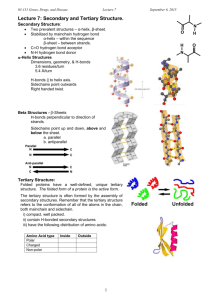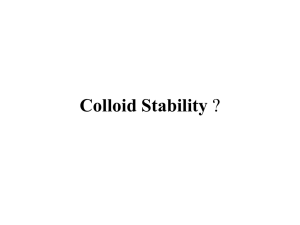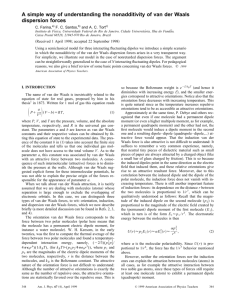472-322
advertisement
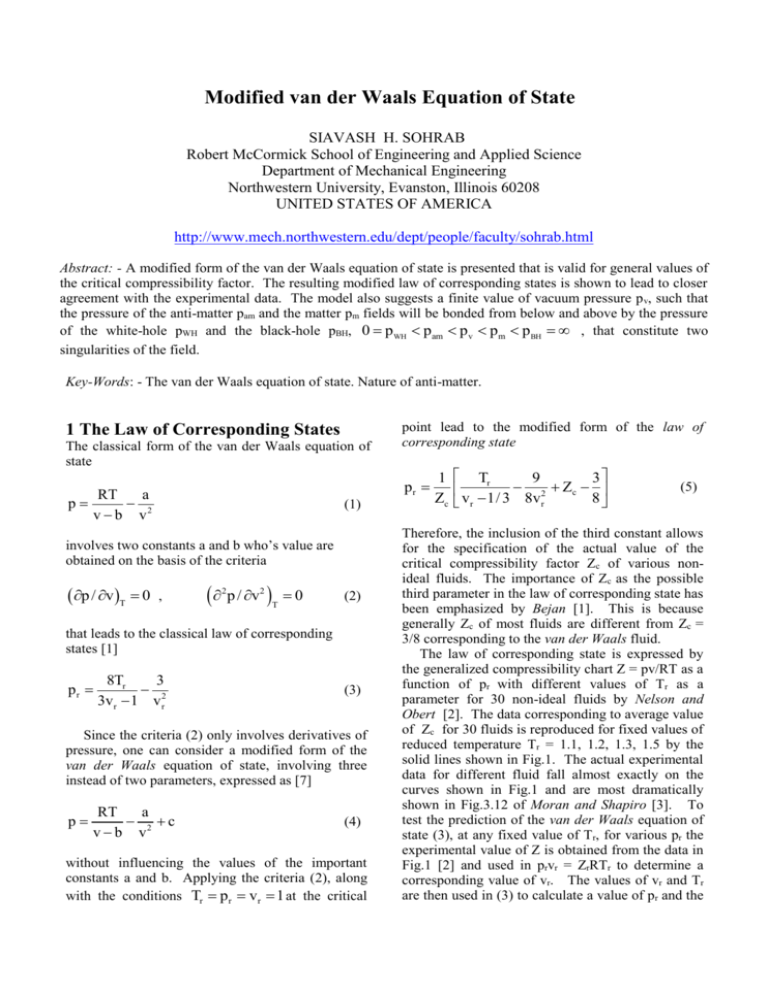
Modified van der Waals Equation of State SIAVASH H. SOHRAB Robert McCormick School of Engineering and Applied Science Department of Mechanical Engineering Northwestern University, Evanston, Illinois 60208 UNITED STATES OF AMERICA http://www.mech.northwestern.edu/dept/people/faculty/sohrab.html Abstract: - A modified form of the van der Waals equation of state is presented that is valid for general values of the critical compressibility factor. The resulting modified law of corresponding states is shown to lead to closer agreement with the experimental data. The model also suggests a finite value of vacuum pressure p v, such that the pressure of the anti-matter pam and the matter pm fields will be bonded from below and above by the pressure of the white-hole pWH and the black-hole pBH, 0 p WH pam p v pm p BH , that constitute two singularities of the field. Key-Words: -Thevan der Waals equation of state. Nature of anti-matter. 1 The Law of Corresponding States The classical form of the van der Waals equation of state RT a p 2 vb v (1) involves two constants a and b who’s value are obtained on the basis of the criteria p / v T 0 , p / v 2 2 T 0 (2) that leads to the classical law of corresponding states [1] pr 8Tr 3 2 3v r 1 v r (3) Since the criteria (2) only involves derivatives of pressure, one can consider a modified form of the van der Waals equation of state, involving three instead of two parameters, expressed as [7] p RT a 2 c vb v (4) without influencing the values of the important constants a and b. Applying the criteria (2), along with the conditions Tr pr vr 1 at the critical point lead to the modified form of the law of corresponding state pr 1 Tr 9 3 2 Zc Zc vr 1/ 3 8v r 8 (5) Therefore, the inclusion of the third constant allows for the specification of the actual value of the critical compressibility factor Zc of various nonideal fluids. The importance of Zc as the possible third parameter in the law of corresponding state has been emphasized by Bejan [1]. This is because generally Zc of most fluids are different from Zc = 3/8 corresponding to the van der Waals fluid. The law of corresponding state is expressed by the generalized compressibility chart Z = pv/RT as a function of pr with different values of Tr as a parameter for 30 non-ideal fluids by Nelson and Obert [2]. The data corresponding to average value of Zc for 30 fluids is reproduced for fixed values of reduced temperature Tr = 1.1, 1.2, 1.3, 1.5 by the solid lines shown in Fig.1. The actual experimental data for different fluid fall almost exactly on the curves shown in Fig.1 and are most dramatically shown in Fig.3.12 of Moran and Shapiro [3]. To test the prediction of the van der Waals equation of state (3), at any fixed value of Tr, for various pr the experimental value of Z is obtained from the data in Fig.1 [2] and used in prvr = ZrRTr to determine a corresponding value of vr. The values of vr and Tr are then used in (3) to calculate a value of pr and the 2 resulting calculated data points are also shown as solid circles in Fig.1. The critical properties of ethylene with Zc = 0.276 are used for these calculations in view of available experimental data at all Tr values shown in Fig.1 [3]. Z 1.5 1.3 1.2 T r = 1.1 The agreement of the modified theory in Fig.2 is seen to be somewhat closer than that of the classical theory shown in Fig.1. Further systematic examination of the modified form of the van der Waals equation of state (4) for various fluids with Zc substantially different from the average value such as water, ammonia, hydrogen, Zc 0.275 neon with Zc (0.229, 0.242, 0.305, 0.311) will be interesting. 2 The Finite Pressure of Vacuum It is noted that in the limit vr , the modified form of the van der Waals equation of state (4) leads to negative values of pressure since the inequality pr Fig.1 Comparisons between experimental data (solid lines) and the calculations (solid circles) based on the van der Waals equation of state. Next, to test the predictions of the modified form of the van der Waals equation of state (4), one introduces a constant value of the critical compressibility factor Zc 0.275 that is based on the data given in Table 6.2 of Bejan [1, 4]. Again, at any fixed Tr, for various values of pr the corresponding experimental values of Z are obtained from the data in Fig.1 [2] and the results are used in prvr = Zr RTr to evaluate vr. The values of (vr, Tr) are then introduced in (4) to calculate the predicted value of pr. The results of such calculations based on critical properties of ethylene at the reduced temperatures Tr = 1.1, 1.2, 1.3, and 1.5 are shown in Fig.2. Zc < 3/8 = 0.375 appears to hold for most fluids [1]. However, because thermodynamic pressure may be viewed as the volumetric energy density of the field [5], negative values of pressure are expected to be nonphysical. This in turn suggests that pr in (4) may in fact be a gage pressure prg rather than an absolute pressure pra that are related to the finite absolute vacuum pressure prv by the expression p rg p ra p rv , such that (4) becomes prg pra prv 1 Zc Tr 9 3 2 Zc (7) 8 vr 1/ 3 8vr Now, in the limit vr since pra 0 , one obtains from (7) a finite and positive vacuum pressure of p rv Z (6) 3/8 1 0 Zc (8) 1.5 1.3 1.2 T r = 1 .1 pr Fig.2 Comparisons between experimental data (solid lines) and the calculations (solid circles) based on the modified van der Waals equation of state. A finite vacuum pressure is in harmony with the well-known finite value of the zero-point energy [5]. It is then reasonable to suggest that the Dirac Sea associated with anti-matter should correspond to pressures lower than that of the vacuum [6]. Hence the pressure of matter pm and anti-matter pam fields will be respectively larger and smaller than vacuum pressure pv [6] 0 p WH pam p v pm pBH (9) 3 and ultimately limited by the pressures of white hole p WH 0 and black hole pBH that are the two singularities of the field. Under such a model, the conservation of physical space i.e. vacuum [6-8], requires a symmetry between matter particles and their conjugate antimatter particles such that their interactions leads to mutual annihilation and generation of vacuum, thereby resolving the flatness-paradox of cosmology. Also, the conservation of angular momentum requires that the spin of matter versus their conjugate anti-matter particles be reversed, thereby naturally accounting for the time-reversal paradox. REFERENCES [1] [2] [3] Bejan, A.,. Advanced Engineering Thermodynamics, Wiley, 1988. Nelson, L. C., and Obert, E. F., Generalized pvT properties of gases, Trans. ASME 76, 1057-1066 (1954). Moran, M. J., and Shapiro, H. N., Fundamentals of Engineering Thermodynamics, Wiley, 1988. [4] [5] [6] [7] [8] Reid, R. C., Prausnitz, J. M., and Sherwood, T. K., The Properties of Gases and Liquids. 3rd ed., McGraw Hill, New York, 1977. Sohrab, S. H., A scale-invariant model of statistical mechanics and modified forms of the first and the second laws of thermodynamics. Rev. Gén. Therm. 38, 845854 (1999). Sohrab, S. H., Stochastic definitions of Planck and Boltzmann constants and quantum theory of gravitation. Bull. Am. Phys. Soc. 46, No.2, 160 (2001). Sohrab, S. H., Modified form of the van der Waals equation of state Bull. Am. Phys. Soc. 48, No.1, 432 (2003). Sohrab, S. H., Some thermodynamic considerations on the physical and quantum nature of space and times WSEAS Transactions on Mathematics Issue 4, Vol.3, 764-772 (2004).
